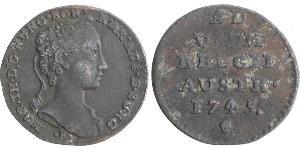(售价 $31.0)
1346, Bohemia/Poland, John of Luxemburg "The Blind". Silver Prague Grossus Coin. VF+
He was King of Bohemia, and titular King of Poland. R!
Mint Place: Kuttenberg
Mint period: 1310-1346 AD.
References: Donebauer 817, Smolik 1.
Condition: Minor weakness of strike, a few scratches, otherwise VF+
Denomination: Prague Grossus ("Pragergroschen").
Diameter: 29mm
Material: Silver
Weight: 3.68gm
Obverse: Rampant Bohemian lion left, with forked tail.
Legend: +* GROSSI * PRAGETISES *
Reverse: Crown with two lis symbols inside, pellet above, two bands of legends around.
Legend: +IOhANNES:PRIMVS / +DEI:GRATIA*REX:BOEMIE
From 960-1260, coins circulated freely only in areas surrounding Prague, creating a trading network with some specialization. In the rural areas, peasants continued to trade food and forest products for manufactured goods, while in the farther regions of Bohemia the economy remained centered in tribal hillforts and the immediate local availability of goods.
However, everything changed with the discovery of silver mines in Bohemia. From 1250-1412, preciousmetalproduction shifted from western europe to Bohemia. The massive output of silver mines at Jihlava enabled King Otakar II to draw 2000 marks, or 4 tonnes of silver, per year for his own personal coffers. In 1298, "a's silver stores were discovered and in its first, this mine produced 6.5 tonnes of silver. Although throughout its operation 1298-1420, the diminishing output ended up averaging two tonnes of silver per year.
The new supplies of silver and gold flooded economies everywhere in East Central Europe, leading to inflation in price and a suddenly very wealthy international merchant class. Coin issues were regularized with the new large groschen. This coin was the heaviest coin struck in Bohemian history, leading to its name â€Å"denarius grossus," or â€Å"heavy dinar". The Prague Grossus was first struck in "a in 1300 by King Vaclav II.
As far as income goes, a skilled artisan or mercenary soldier in 15th century Prague made 1 groschen per day as a wage or living allowance.
John the Blind (10 August 1296 - 26 August 1346) was the Count of Luxembourg from 1309, King of Bohemia, and titular King of Poland from 1310. He was the eldest son of the Holy Roman Emperor Henry VII and his wife Margaret of Brabant.
John was French by education, but deeply involved in the politics of Germany. In 1310, John married Elisabeth,heiress of Wenceslaus III of Bohemia, and thereby became King of Bohemia and so one of the seven prince-electors of the Holy Roman Empire. The object of the hostility of the Czech nobility, however, he gave up the administration of Bohemia and embarked on a life of travel, spending time in Luxembourg and the French court. His travels took him to Silesia, Poland, Lithuania, Tyrol, Northern Italy, Papal Avignon, and Languedoc, where he was governor from 30 November 1338 to November 1340. He lost his eyesight from ophthalmia, while crusading in Lithuania with the Teutonic order.
He retained his crown even after Elisabeth's death in 1330. His second wife was Beatrice, daughter of Louis I, Duke of Bourbon.
He was killed whilst fighting alongside the French against the English at the Battle of Crecy, part of the Hundred Years' War. The chronicler Froissart left the following account of John's last actions:
...for all that he was nigh blind, when he understood the order of the battle, he said to them about him: 'Where is the lord Charles my son?' His men said: 'Sir, we cannot tell; we think he be fighting.' Then he said: 'Sirs, ye are my men, my companions and friends in this journey: I require you bring me so far forward, that I may strike one stroke with my sword.' They said they would do his commandment, and to the intent that they should not lose him in the press, they tied all their reins of their bridles each to other and set the king before to accomplish his desire, and so they went on their enemies. The lord Charles of Bohemia his son, who wrote himself king of Almaine and bare the arms, he came in good order to the battle; but when he saw that the matter went awry on their party, he departed, I cannot tell you which way. The king his father was so far forward that he strake a stroke with his sword, yea and more than four, and fought valiantly and so did his company; and they adventured themselves so forward, that they were there all slain, and the next day they were found in the place about the king, and all their horses tied each to other.
After the battle, legend states that John's personal crest (a pair of black wings) and motto Ich dien ("I Serve") were adopted in slightly modified form by Edward, the Black Prince, and since then they have been part of the badge of the Prince of Wales.
John was succeeded as King of Bohemia by his eldest son Charles (later Charles IV, Holy Roman Emperor). In Luxembourg, he was succeeded by his son by his second wife, Wenceslaus.
2 Stuiver 荷兰 銀
本组有 33 钱币 / 33 售价
⇑
1 Liard Austrian Netherlands (1713-1795) 銅
本组有 4 钱币 / 4 售价
⇑

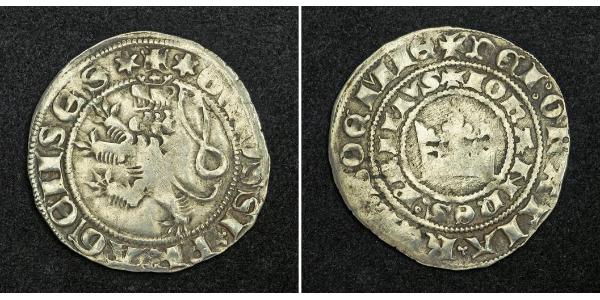





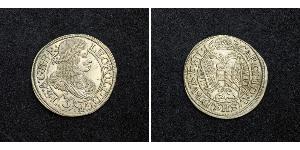

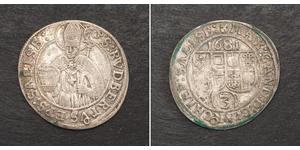






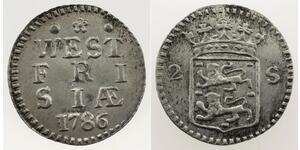
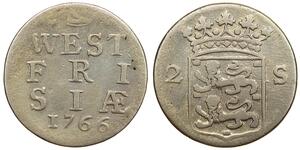
-300-150-P8gsHgTy6VEAAAGTRmDWdZPt.jpg)
